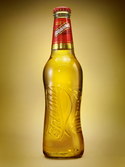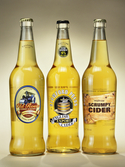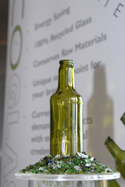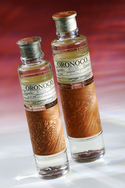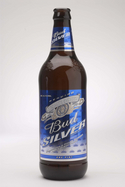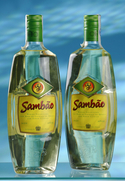Clear as crystal
1 September 2006Glass is more than holding its own in the beverage markets. Pauline Covell reports on how quality perception and innovation in this oldest of pack forms should ensure continuing strong performance in its third millennium
To many brand owners glass represents the ultimate container of quality, purity, clarity and substance. Yes, it breaks and some might say that if invented today would not stand a chance in a market dominated by plastics. But technology advances have led to far less chance of a bottle shattering on the floor. As marketing manager of Rockware Sharon Crayton explains: “As lightweighted bottles have become more prevalent they have also become stronger. If you cut through an old bottle there would be a wavy profile with thin and thick sections. Now you would see a much more consistent wall thickness - a stronger container.”
Glass packaging continues to dominate many key international packaged goods markets, reports O-I. Of the 53.3 billion tonnes of glass containers produced worldwide in 2005, some 42 per cent were made in Europe, while 27 per cent were produced in both the Americas and Asia Pacific.
According to Market and Business Development in its recently published UK Glass Packaging Market Development Report the UK market increased by one per cent in 2005 to reach £643.2M. Interestingly it reports that the proportional importance of glass increased from seven per cent in 2004 to eight per cent last year.
“Our two biggest growth sectors have been beer, the largest by far in the UK and growing for us at two per cent a year, and secondly the soft drinks market,” says Crayton. “Soft drinks seems to be predominantly in plastics, but in the on-trade Coca-Cola and Britvic J20, for example, have made the move to change from returnables to one-trip bottles. We’ve seen these decisions because of branding. Consumers want parity with the beer drinkers who have the long necked bottles. They want a premium trendy product. In pubs a lot more soft drinks are now the norm.”
With far more beer being drunk at home pack formats are reduced to two – cans and bottles. “There is no draught and here glass is loved for the premium image,” Crayton explains. “We have seen some growth in wine and in the new cider trends, but the big push has been for beer.”
O-I concurs. “In the US, as in most markets, glass packed beers have led the way, with glass packaging for local beer consumption taking an additional 17 per cent of the total packaged beer sector over the period 1990 – 2004. In Latin America too, glass production for the beer market has risen by nearly 3,000m units a year over a similar period. Returnable bottles have established themselves as the main container for beer consumption, but their rise has not been at the expense of non-returnable containers; rather it has outstripped alternative packaging formats.”
Key to this success, says the company, is the differentiation that a glass bottle can provide. In the early 1990s, only amber bottles in very few shapes were used. Now there are many shapes, capacities and designs available using a variety of colours, including amber, flint, green and blue glass – all vital factors in the rise of brand success in beer and other drinks sectors (such as soft drinks).
In common with most of Europe, beer consumption in the UK is falling, especially in the on-trade. However some packaged beer sectors are performing strongly with sales in both cans and glass bottles on the rise, reports O-I” “The much heralded push from PET into the UK beer market appears to have run out of steam, as a combination of consumer dislike of the material, environmental considerations and costs hit home.”
New categories, such as Weissbier have established themselves in glass during recent months and premium lager, both imported and domestically produced, is attracting more interest. With government and industry focus on responsible drinking, it seems consumers are choosing to drink less beer but what they do drink is of better quality and often glass packed, says O-I.
New product examples include Coors Casteel Cru, with its premium appeal emphasised with a champagne-style container and Brahma, the Brazilian beer with its flowing ‘S’-shaped container. Premium packaged ales in 500ml and larger glass bottles continue to make an impact. Suffolk brewer Adnams has announced the repackaging of its successful ales in O-I glass.
At the same time as increases in penetration in certain markets overcapacity in the UK, reported by Market & Business Development, “has had a detrimental impact on prices and, together with the ongoing effects of retailer power in the grocery sector, this has exerted a downward pressure on prices.” Sharon Crayton comments: “It is not something we as a company are seeing at the moment. We have a full order book. We’ve invested in highly efficient plant and we have not brought our prices down, although I obviously can’t speculate about other companies.”
The trend towards healthy eating and ethical products is good news for glass, which is positioned as an inert non-contaminating medium. Crayton adds: “This market is something I am very optimistic about. In all our consumer research they always say they prefer the taste from glass. (UK TV chef) Jamie Oliver has had an impact here too. The consumer is very concerned about what they eat. Glass is well positioned to address that as it is an inert material.” Crayton cites the Dr Gillian McKeith organic juice energy drink. “On the label it says ‘Packed in glass, because glass is purer, healthier for the environment, and glass does not have outgases leeching into the juices; thus our juices taste great’. There is not much point in taking additives out of a product if you don’t pack it in an inert material.
In all geographic areas the core benefits of glass strike a chord with modern consumers, confirms O-I. “Poll after poll reveal consumers believe glass does not taint the taste of the product it packs, is a pure container and is totally recyclable. In a world where health and the environment are major concerns, these strengths of glass, coupled with the brand differentiation a glass design can bring, are creating a strong demand for the material – demand which in Europe sees O-I produce over 1,500 brand new packs for customers every year.
Recently developed by Rockware is EcoGlass, which comprises 100 per cent cullet. “We use a lot of cullet, but in the UK there is a big imbalance in what we can use. Of the 1.2billion bottles of wine consumed here some 90 per cent are imported filled. UK producers don’t make anything like that amount of green glass,” explains Sharon Crayton. “And now, because councils are doing doorstep collections, much more of the glass is being mixed so we are losing flint glass.
“We asked ourselves if we could make anything out of the mixed glass. We have already done a trial in a small furnace. It produces an attractive emerald green colour. We are already seeing interest from the retailers.”
The UK alcoholic drinks market remains strongly committed to glass packaging. This commitment is supported by continued consumer support for the material, as shown by research from trade association British Glass. Fifty five per cent of consumers would, the research reveals, prefer to see more products packed in glass, while two thirds claim that food and drink tastes better out of glass. Environmental benefits of glass are also recognised, an important factor given the increasing emphasis on sustainability. Seventy-four per cent of consumers apparently believe glass is “|more natural” than other materials and 63% believe it is better for the environment.
Demand for spirits containers rose in 2005 to nearly 1,360m units, “but predictions for 2006 are difficult as the majority of UK bottled spirits are sold overseas, where there can be large fluctuations in demand,” says O-I. “In the UK market, the Ready to Drink (RTD) sector has had a particularly torrid time. Distillers recognise the constant need to develop and launch successful new drinks and boost the market share of their existing brands. Packaging plays a vital role in achieving commercial success and glass remains the undisputed pack of choice.”
Top prizes awarded recently in the UK’s 2006 Starpack competition reflect the innovation in design of glass containers for the spirits market. The Supreme Gold Award was given to Diageo for its leather covered slender glass bottle for Oronoco Rum. Designed by Gordon Smith, of Smith & Co, and manufactured by Saverglass, Feuquieres in France, the pack also gained three other Gold Stars in different categories and was a finalist in the Rockware Glass Freshthinking Award: Best Innovation in Glass Packaging. Terry Robins, chairman of the judging panel, says: “The bottle features a unique use of materials, blending a heavily embossed map on a leather sheath wrapped around a beautifully designed and technically clever glass bottle to produce a tactile pack that just has to be touched and owned.” The judges declared it to be a “stunning pack combining technical difficulty with real shelf presence”. The technical challenge lay in finding the correct leather in terms of thickness, ability to emboss, colour and adhesion. The leather used includes a latex additive, which allowed the material to bend around the bottle and also ensured good custom-colour matching and embossing. The wrap is applied using double-faced tape.
Best Innovation in Glass Packaging award and Gold Star went to Allied Glass Containers and Diageo for the distinctive Sambao Cachaca Spirit lime wedge triangular-shaped white flint glass bottle, which features high shoulders and fine embossing to create a technically difficult and innovative pack. The Starpack judges said: “The bottle’s delicate and complex front curves, and wedged back, push the technical boundaries of glass bottle manufacture. It captures the quality image of the brand and is an outstanding technical achievement and marketing success.” It combines complex design and developmental production techniques.
Manufactured and designed by Allied Glass Containers, the container’s extreme profile is created by production techniques including a “non-conventional mould” featuring an undulating-staggered mould joint that runs the entire length of the bottle.
Development of the container took some 12 months. Packaging & dispense innovation director at Diageo Innovation Mark Harrison told Packaging Today: “We work very closely with the design agency, the supplier side and the glass bottle manufacturer. We have to ensure that the essence of the design is retained while at the same time ensuring that the container will run down the line and can be made. The Sambao bottle is such an unusual and innovative shape.” Clearly elated with the company’s Starpack success he added: “There is lots more to come.”
Innovation is key to ensuring continuing longevity for this most ancient of pack formats. Rockware’s planned innovation process began some eight years ago “precisely because we wanted people to see we were not old-fashioned and inflexible. We looked at consumer needs and trends, for example functionality and ease of opening. A good example is the recently launched Bud Silver.” A pint bottle, it features four finger grips down the back. “Although it is more masculine it still allows ease of use,” adds Crayton.
And what can we expect in the future? “Consumers don’t just want a product,” she says. “They want interactive packs. We have also asked the question why the bottles have to be so regimented. We have machines with lots of moulds. We have spent years trying to conform, but what if each pack was subtly different yet still of the right height and right diameter?”
